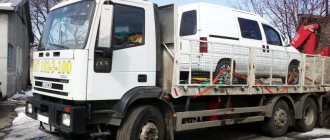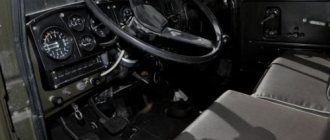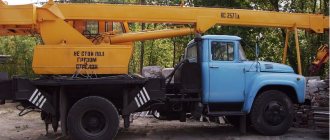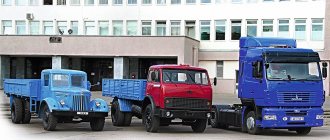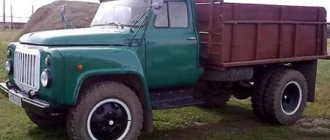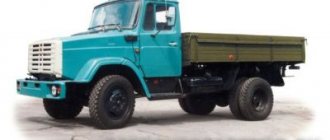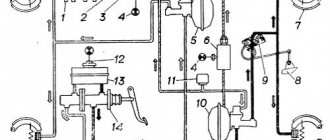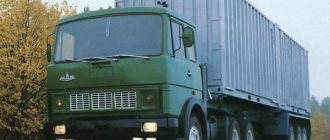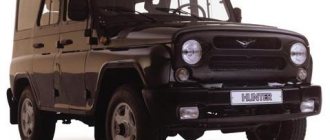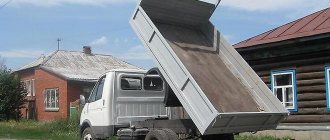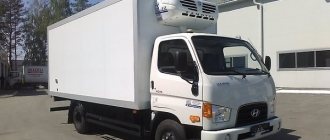Timely delivery of cargo is an integral part of the service and the key to satisfied customers. But the desire to quickly get to your destination is fraught with neglect of safe driving rules.
When purchasing any new or used semi-trailer, it is important to consider modern safety features. In addition, following a few simple tips for driving a truck can significantly reduce the risk of an accident on the road and make it safer for you and other drivers.
Tips from a professional truck driver.
A truck driver (Alexei Amelin) contacted our editorial office with some good advice, in our opinion, who drove a heavy-duty vehicle without an accident for almost 1.3 million kilometers in eight years. Over the course of these eight years, Alexey practically traveled all over Russia, transporting various goods between regions of the Russian Federation. This driver sent us tips that we think can help many car enthusiasts become more experienced drivers in the winter and avoid getting into an accident.
When, while driving, you unexpectedly encounter a winter snowstorm, a storm or a blizzard, then you need to be very careful when making a decision. After all, your own safety depends on this. If you and your friends have stopped to wait out a snow storm, then if you do not have an emergency kit with you that will help in case of unforeseen events in the winter, then never get out of the car. This is especially true for your warm clothes and those items that can help clear snow drifts around the car.
When driving a car in difficult winter conditions, you must learn and know a number of important rules for you on how exactly you should behave while driving a car in bad blizzard weather in winter.
Below, dear friends, you can read and get acquainted with the advice that our regular reader, a truck driver, sent us to the editor.
Types of gear
A car with a manual transmission has the following gears:
- Reverse gear is the most “powerful”. You need to drive it slowly, with the clutch half-depressed. Otherwise it can easily skid.
- Neutral - when the gear knob is in free movement in the middle. You can check whether the car is “in neutral” by easily shaking the handle from side to side.
- The first speed is used for starting. For further movement, it is recommended to turn on the second one.
- The second, third and so on are used to move the car at different speeds.
When focusing on the speedometer, you need to remember:
| Broadcast | Speed, km/h |
| 1 | 0-20 |
| 2 | 20-40 |
| 3 | 40-60 |
| 4 | 60-90 |
| 5 | 90-110 |
| 6 | over 110 |
These are approximate speed range recommendations. Experienced drivers determine by the sound of the engine when it is time to change gears.
Reduce your speed.
If you are driving too fast, be sure to reduce your speed by half if weather conditions worsen. If you have the skill of slowing down a car specifically on snow or ice, then you can safely reduce the speed of your vehicle in a short time. Please remember that no one has yet canceled the laws of physics. It is for this reason that you should not be so sure that your car will stop quickly on a slippery road. If you start to slow down sharply, you increase the risk of your car skidding and losing traction.
If your car has low ground clearance (clearance), then by reducing its speed you will reduce the formation of snow stuck under the bottom of your car, which always prevents the car from moving smoothly along the road.
Where to study
In search of an answer to the question “How to drive a truck correctly?” it is necessary to consider all possible options. You can learn how to masterly drive a vehicle by taking driving courses at a driving school , where the main focus is on driving with an instructor.
To save time, watch free educational material on YouTube. For example, this one:
For those who want to learn the basics of driving at home, online simulators . They have a number of varieties, are thoughtful and realistic.
Be careful.
Your actions on the winter road must be completely controlled and deliberate. Remember, friends, that rapid acceleration, as well as sudden braking and sharp turns of the steering wheel can cause loss of control and skidding of your vehicle.
When driving a car, maintain an optimally low speed. Keep your distance from other vehicles at the angle required for emergency braking of your vehicle. All movements should be smooth and careful, not abrupt.
Use light signals.
Many truck drivers around the world use a special vehicle driving technique when driving a car on the highway to change lanes. In dry or rainy weather, in autumn, summer and spring, before changing lanes in the car, the driver of the truck turns on the turn signal and begins to change lanes only after the turn signal blinks three times. That is, only on the third blink of the turn signal the driver begins to change lanes in the car. But in winter weather, it is best to start changing lanes in your car from one lane to another after the turn signal flashes 4-5 times.
If for some reason your driving speed in winter is lower than that of other road users, then please change lanes to the right and turn on the hazard lights (hazard warning lights). This way you will warn other car drivers that you are not just driving at a slow speed out of nothing to do. This will protect not only you, but also other road users.
In addition, by turning on the hazard warning light you will prevent cars from congesting behind you and will not cause irritation to most car drivers.
Braking distances
Driving a truck is a difficult and complex process, which includes a number of features. Anyone can stop a car on dry asphalt, but on a slippery surface, most people need to learn. Drum brake systems are often used in our country. They are slightly worse than disk ones, which are common in Europe.
The braking distance of a truck moving at a speed of 80 km/h from the moment of braking until the speed drops to zero on drum brakes will be 60 m, on disc brakes – 45 meters.
It would seem that the difference is small, but it can save someone's life. The braking distance is affected by the condition of the tire, tires used and suspension.
You can see what the braking distances of different trucks look like and compare them here:
Be careful on slippery roads.
Pay attention to water on the road under the wheels of other vehicles when driving in cold weather. If there is a lot of water splashing on the road from passing vehicles, then the road is currently very wet. In this case, you need to take additional precautions. The point here is this: at subzero temperatures, snow or ice melted from car wheels or from a reagent begins to quickly freeze and turns the road into a solid skating rink. If you suddenly see that the road is quite wet, and there are practically no splashes of water from cars, then be more attentive and careful at such a moment, since this road surface is considered the most dangerous. The absence of splashes on a wet road may tell you that most of the water on the road has simply frozen and covered the asphalt with a thin layer of ice.
Watch out for truck drivers.
If the weather begins to deteriorate sharply and trucks slow down, you, for your part, must do the same. If you have begun to notice that many drivers of heavy vehicles are trying to pull over to the side of the road and stop, then we advise you, friends, to do the same in bad weather. In no case does this advice, dear friends, recommend or force you to do the same thing and drive exactly the same as the same truck drivers. The point is different, namely this: all heavy-duty vehicles have much greater ground clearance (clearance) than passenger vehicles, these vehicles have larger wheels and tires themselves, and of course, naturally, a greater total weight. Just remember, friends, that the lighter the car is, the easier it loses traction with the road itself. Also, do not forget that the majority of truck drivers are specific professionals and they (many) have millions of kilometers traveled behind them. That is why they are more confident and feel at home behind the wheel; it is not a sin to pay attention to them when driving your car in bad or terrible weather.
Why do you need the ability to drive a car with a manual transmission?
Some driving schools provide services such as driving lessons exclusively for automatic cars. This means that the corresponding rights will be issued. That is, then it will not be possible to drive a manual transmission without obtaining a new license.
Various situations arise in life, and sometimes there is an urgent need to drive a car with a manual transmission. Once you have the license to do this, you can always switch to an automatic car. On the contrary, it will not work.
Buying a car with a manual transmission is a more profitable purchase. In addition to the lower price of cars, their operation will also be more economical. As a rule, their fuel consumption is lower, and the repair of some parts will also be less expensive.
In a situation where the battery is low, you can get out of the situation. For example, transferring wires from another car for recharging. Or the car can start from the so-called pusher. These options are not suitable if the vehicle has an automatic transmission.
Only using a manual transmission can you feel full control over the car. When many manipulations are performed automatically, this does not happen.
Do not stop.
If a snowstorm or fog takes you by surprise while driving and you cannot see anything beyond the hood of your car, then do not stop suddenly. In order to stop, you need to choose the optimally safe and correct place. After all, if you suddenly stop your car at such a moment, you may simply be covered in snow and your car will get stuck. As a rule, during heavy snowfalls, even many federal highways are cleared of snow by special equipment, including the roadsides and the exits themselves.
Wait out the bad weather.
The best and most practical advice for motorists in case of poor visibility in winter is to leave the highway itself, go to a cleared area or a gas station, a hotel, a cafe or maybe a restaurant. By parking your car, you can wait out the storm at a convenience store at a gas station, etc. and so on. place.
Driving a car in heavy snow (snowfall) is very dangerous. And almost all drivers of large trucks understand this.
Vehicle traction.
During the winter season, many cars often lose traction due to slippery roads. But if you, friends, think that the reason for everything is ice on the road, then this is far from the case. In fact, the traction of a car is reduced precisely because of the lack of water between the tires and the road surface, which reduces the traction of a car in winter. It’s worth noting right away that when there is slight frost, a thin film of water forms on the road, which can contribute to micro-aquaplaning of the car itself, which can lead to an unexpected skid.
Therefore, dear motorists, do not forget and be sure to use only winter tires with deep tread in the winter season. Also, this rubber should have small notches on the tread, which improve traction on compacted snow or on icy roads.
Extreme cold is not necessarily your enemy.
The biggest risk for any driver is to lose traction in winter, which is observed at air temperatures from +1 to -3 degrees. In colder weather -6 to -12 degrees or colder, the vehicle has more traction and is less likely to skid than in warmer temperatures.
You do not believe? Try this for yourself: -Take two ice cubes. Place one in a glass of water and put the other in the freezer for 30 minutes. Now try to lift an ice cube from a glass of water with your finger.(?) Pay your attention to how slippery this ice cube is, isn’t it? After 30 minutes, touch the ice cube with your fingers. Your fingers will literally practically stick to it. Here's your answer.
The same principle applies to driving a car itself. Ice becomes very sticky in severe frosts. But when the car moves quickly or slowly, a much larger amount of heat begins to affect the ice, which contributes to a greater melting of this ice crust on the road. Naturally, this subsequently reduces the traction of the car itself.
Ultimately, we can sum it up. Only you are personally responsible for the decisions you make when driving your car on the road. The most important thing depends only on you, whether you make the right or another decision while moving along the road. If the road is too bad, we hope that you will make the right decision and stop. Let the road services rack their brains and do their job, let them clear the road better.(!)
Start of movement
Procedure:
- Before turning the key in the ignition, you must fully depress the clutch pedal with your left foot, and press the brake with your right, and only then start the engine. The engine is started, the clutch is depressed, you can engage first gear (before this, the selector is in the neutral position). To prevent the car from stalling, you must not release your left foot from the pedal. When the car is running, from the brake, the foot moves to the gas pedal and at the same time it is necessary to begin to remove the foot from the clutch, only smoothly.
- To change to the next speed, the tachometer needle must be equal to 3000 rpm. If you shift too early, the car may stall.
How the transition is performed:
- The right foot is removed from the gas, and the clutch is fully depressed with the left, and at this time the selector is moved to the required position,
- The clutch must be released and the gas pedal pressed,
- Next, only the right leg participates in control until moving to the next speed or stopping.
More experienced drivers usually do not pay attention to the tachometer readings, but focus on the sound of the engine.
If the car does not accelerate and the speed is too low, then you need to switch to a lower speed. And if the speed is too high, then it is necessary to switch on the next speed so as not to overload the engine.
